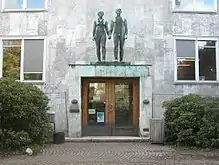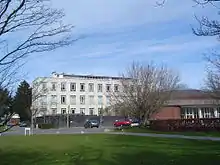UCPH Department of Computer Science
The UCPH Department of Computer Science (Danish: Datalogisk Institut, DIKU) is a department in the Faculty of Science at the University of Copenhagen (UCPH). It is the longest established department of Computer Science in Denmark and was founded in 1970 by Turing Award winner Peter Naur. As of 2021, it employs 82 academic staff, 126 research staff and 38 support staff. It is consistently ranked the top Computer Science department in the Nordic countries, and in 2017 was placed 9th worldwide by the Academic Ranking of World Universities.[3]
 Entrance of the main building, located at the University Park in Copenhagen, on the university's North Campus | |
| Type | Public |
|---|---|
| Established | 1970[1] |
Parent institution | University of Copenhagen, Faculty of Science |
| Head of Department | Professor Jakob Grue Simonsen[2] |
| Location | , 55°42′08″N 12°33′41″E |
| Website | di |
 | |
History
DIKU has its roots at the Institute for Mathematical Sciences, where in 1963, the first computer was bought.[4] In 1969, Peter Naur became the first professor in Computer Science at the University of Copenhagen, and in 1970, DIKU was officially established its own department.[5]
Research
As of 2021, the department is home to 82 academic staff, 126 research staff and 38 support staff. Research is organised into seven research sections:[6]
- The Algorithms and Complexity Section, headed by Mikkel Thorup, who conduct basic algorithms research, as well as research on data structures and computational complexity
- The Human‐Centered Computing Section, headed by Kasper Hornbæk, who research human-computer interaction, computer-supported cooperative work, as well as health informatics
- The Image Section, headed by Kim Steenstrup Pedersen,[7] who work on image processing including medical image processing, computer vision, physics based animation and robotics.
- The Machine Learning Section, headed by Christina Lioma,[8] researching theoretical machine learning, information retrieval, and machine learning in biology
- The Natural Language Processing Section, headed by Isabelle Augenstein,[9] who conduct research on core natural language processing, natural language understanding, computational linguistics, as well as multimodal learning
- The Programming Languages and Theory of Computation section, headed by Martin Elsman,[10] researching programming languages, theory of computation, computer security, and approaches to financial transparency
- The Software, Data, People & Society Section, headed by Thomas Troels Hildebrandt,[11] who work on decentralised systems, data management systems, and process modelling
Teaching
The department offers programmes at BSc as well as MSc level, both in core computer science and in interdisciplinary subjects. Bachelor's programmes are 3-year programmes and mostly taught in Danish, whereas Master's programmes are 2-year programmes and taught in English. In 2020, DIKU enrolled 610 new Bachelor's students and 136 new Master's students.[12] As of 2021, DIKU offers the following study programmes:[13]
- Bachelor of Science (BSc) in Computer Science
- Bachelor of Science (BSc) in Machine Learning and Data Science
- Bachelor of Science (BSc) in Computer Science and Economy
- Bachelor of Science (BSc) in Communication and IT
- Bachelor of Science (BSc) in Health and IT
- Master of Science (MSc) in Computer Science
- Part-time Master of Science (MSc) in Computer Science
- Master of Science (MSc) in IT and Cognition
- Master of Science (MSc) in Communication and IT
In addition, the department awards the research degree Doctor of Philosophy (PhD). PhD students are enrolled in the Faculty of Science's Doctoral School for a typical study period of between three and four years.[14]
Location


DIKU is based at University Park in Copenhagen, part of the university's North Campus. Its building complex comprises the former Department of Anatomy. The building was completed in 1942 to design by Kaj Gottlob.[15]
The Human-Centered Computing Section is located in Sigurdsgade, close to the North Campus.
Student life
An important social event is the DIKU revue which is held each year in June. The DIKU revue is always in competition with the physics revue and never misses an opportunity to computer-animate the complete and utter destruction of the physics institute at the H. C. Ørsted Institute.
As something unique among the institutes of Copenhagen University, the DIKU cantine is entirely student driven and open 24 hours. It is the natural hub for all social events on DIKU.
The two largest social events are the DIKU revue and the Julefrokost (Christmas lunch) of the canteen.
Notable faculty
- Corinna Cortes, who co-developed the highly influential supervised machine learning method support vector machines, has been an adjunct professor at the department since 2011.
- Mikkel Thorup, best known for his work on shortest path problem in undirected graphs, has been a professor at the department since 2013.
- Kasper Hornbæk, who won a SIGCHI Lifetime Achievement Award for his work on usability in human-computer interaction, has been a professor at the department since 2014.
- Serge Belongie, known for his work on object recognition and image segmentation, has been a professor at the department since 2021.
Notable alumni
- Peter Naur, a Turing Award recipient, was a professor at the department between 1969 and 1998.
- Per Brinch Hansen, a IEEE Computer Pioneer Award winner, was a professor at the department between 1984 and 1987.
- Mads Tofte, the first managing director of the IT University of Copenhagen and co-developer of the Standard ML programming language, who graduated with a MSc in Computer Science and Mathematics in 1984.
- Michael Seifert, a Danish computer programmer who developed the popular multiplayer text-based role-playing game DikuMud, was a BSc then MSc student at the department from 1990 to 1996.
Miscellaneous
The domain diku.dk was registered on October 29, 1987, and was one of the first .dk domain names to be registered.[16]
The popular DikuMUD codebase was developed at DIKU in March 1990, and derives its name from the institute.[17]
In the 1994 Danish thriller Nattevagten (Nightwatch) directed by Ole Bornedal, the main entrance and stairwell of the institute was used as a main location.
References
- "About the Department" (in Danish). University of Copenhagen, Department of Computer Science. Retrieved 2 April 2021.
- Kristensen, Tina Virenfeldt (2021-03-08). "New head of the Department of Computer Science, University of Copenhagen". University of Copenhagen, Department of Computer Science. Retrieved 1 April 2021.
- "Shanghai Ranking's Global Ranking of Academic Subjects 2017 - Computer Science & Engineering". Shanghai Ranking. 2018-01-01. Retrieved 1 April 2021.
- "Datalogisk Instituts historie - den lange version" (in Danish). University of Copenhagen, Department of Computer Science. Retrieved 2 April 2021.
- Søndergaard, Ann Steendahl (2010-06-02). "Fra DIKUs historiebog - 1970erne" (in Danish). DIKU. Retrieved 7 January 2016.
- "Department of Computer Science, DIKU". Copenhagen University. Retrieved 2021-04-02.
- Steenstrup Pedersen, Kim. "Kim Steenstrup Pedersen". Retrieved 2 April 2021.
- Lioma, Christina. "Christina Lioma". Retrieved 2 April 2021.
- Augenstein, Isabelle. "Isabelle Augenstein". Retrieved 2 April 2021.
- "Programming Languages and Theory of Computation (PLTC)".
- Hildebrandt, Thomas Troels. "Thomas Troels Hildebrandt". Retrieved 2 April 2021.
- "Ansøgnings- og optagelsestal" (in Danish). University of Copenhagen, Department of Computer Science. Retrieved 2 April 2021.
- "Courses and programmes". University of Copenhagen, Department of Computer Science. Retrieved 2 April 2021.
- "PhD School of Science". University of Copenhagen, Faculty of Science. Retrieved 2 April 2021.
- "Anatomisk Institutlanguage=Danish". Bygningskulturens Hus. Retrieved 29 August 2017.
- "Verdens første domænenavn fylder 30 i dag". Netsite. 15 March 2015. Retrieved 7 January 2016.
- Shah, Rawn; Romine, James (1995). Playing MUDs on the Internet. John Wiley & Sons, Inc. p. 22. ISBN 0-471-11633-5.
DikuMud first appeared in mid-March of 1990 when a group of programmers at the Department of Computer Science at the University of Copenhagen, Denmark got together and began work on a multiplayer game that is similar to but improved on AberMuds. These coders were Hans Henrik Stærfeldt, Katja Nyboe, Tom Madsen, Michael Seifert, and Sebastian Hammer.
